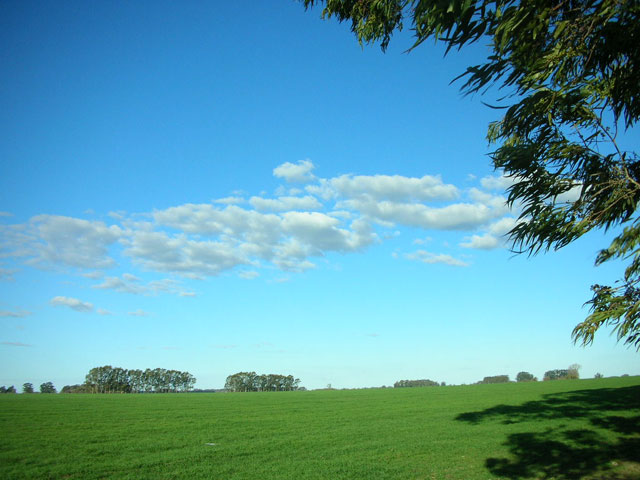The Blogging Farmer
Alex Tiller’s Blog on Agriculture and Farming
Farming on the Bubble: Have Farmers and Investors Fallen Down the Rabbit Hole?
Speculative bubbles have long been a staple of market economies. As one Wall Street investor pithily said, “if a price is free to move, it is free to move stupidly.” Investors sometimes decide that a boom in one sector of the economy is a permanent feature of the landscape, that growth will never end, that double and triple-digit returns on investment are normal and to be expected. Prices will keep going up forever, and it makes good sense to borrow cash in order to invest in a market that endlessly repays investors.
Naturally, none of that is realistic. Industries do grow and new products do come into being--the personal computer or mobile device you are reading this blog post on was part of a new technology that simply didn’t exist before, which created real growth and real profit--but it is very easy for human beings to convince themselves that a short-term trend, like a growth in real-estate prices or the value of tech stock equity, represents a permanent change in the market rather than being a contingent, and temporary, phenomenon. When investors “lose their minds” in this way, the result is a bubble--an ever-increasing price for a good or service, unmoored from considerations of actual return on investment or sustainability. Notorious bubbles in recent U.S. history have included the commercial and residential real estate markets in some (not all) cities and states and the tech equity bubble of the very early 21st century. The most famous historical bubble was the Dutch tulip bulb mania in 1636, during which speculators drove the prices of some tulip bulbs to astronomical heights before the market complete collapsed a few months later.
In the last year or so, a concern has grown up that farmland prices may be showing signs of being overvalued, a possible first sign of a developing bubble. This is not an idle fear, and the issue deserves careful attention and study. Tulip bulbs had no deeper economic significance, tech stock equity plays mainly affected rich capitalists who became somewhat less rich--but farmland is where we grow our food. An economic dislocation in the computer industry means that hard drive prices don’t fall as fast as they used to, or that memory chips are a little hard to come by; an economic dislocation in agriculture could mean that people starve to death. Tulip bulb mania is amusing; farmland mania is potentially terrifying. Since 2000, average farmland prices in the U.S. are up by 58%. Is this an early warning sign that farmers and investors are losing sight of the underlying value of the land?
***
Solar In America’s Heartland
Following the sun across the nation, we see first-hand how solar is working for America and meet today's solar generation: the project developers, manufacturers, installers and of course, the clients - the people who are using solar power in its various forms for their homes, businesses and public buildings. This four-minute film highlights the Solar Generation USA Road Trip as the team discovers how widespread solar energy has become from the East Coast across the Midwest to the West Coast. Learn more about the role solar plays at a boat marina, fire station, New York City rooftop and the Crayola Crayon manufacturing plant, a zoo (with"solar bears"), a gas station converted to a solar charging station for electric vehicles; and see how solar is putting people to work at a manufacturing site and a solar rooftop installation in the West; features a Crayola Crayon factory, Denver International Airport, a Garbett Homes community where solar comes standard, Colorado State University, the San Francisco Giant's ballpark and a Napa Valley vineyard. Visit www.solargenerationusa.org.
Learn more about going solar (www.seia.org/cs/about_solar_energy/how_do_i_go_solar) and about solar technology (www.seia.org/cs/about_solar_energy) at www.seia.org.
Hello, and thanks for checking out my blog. My name is Alex Tiller and I grew up in rural Ohio (Clark County) where my family still owns farmland (corn and beans). I am a member of the American Society of Farm Managers and Rural Appraisers and am also an agribusiness author/blogger. I write about commercial farming, family farms, organic food production, sustainable agriculture, the local food movement, alternative renewable energy, hydroponics, agribusiness, farm entrepreneurship, and farm economics and farm policy. I visit lots of farms in different areas of the country (sometimes the world) that grow all kinds of different crops and share what I learn with you through this blog. You can contact me via email by clicking here: Email Alex at http://blog.alextiller.com/contact
Founder/Publisher/Editor: David McGee
Contributing Editors: Billy Altman, Laura Fissinger, Christopher Hill, Derk Richardson
Logo Design: John Mendelsohn (www.johnmendelsohn.com)
Website Design: Kieran McGee (www.kieranmcgee.com)
Staff Photographers: Audrey Harrod (Louisville, KY; www.flickr.com/audreyharrod), Alicia Zappier (New York)
E-mail: thebluegrassspecial@gmail.com
Mailing Address: David McGee, 201 W. 85 St.—5B, New York, NY 10024



